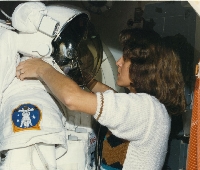
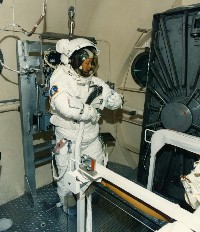
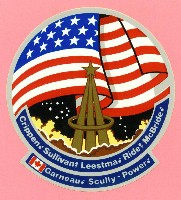 There probably was no formal declaration of the space race, but from the time the first manmade object was put into orbit around the earth by the U.S.S.R, each 'first' was recorded and placed in someone's record book. There are all sorts of firsts: first living creature in space, first man to orbit the earth, first man to perform an EVA and so on. A brief review of the firsts credited to women is given here with a personal account related to one of them.
There probably was no formal declaration of the space race, but from the time the first manmade object was put into orbit around the earth by the U.S.S.R, each 'first' was recorded and placed in someone's record book. There are all sorts of firsts: first living creature in space, first man to orbit the earth, first man to perform an EVA and so on. A brief review of the firsts credited to women is given here with a personal account related to one of them.

|
|---|

|
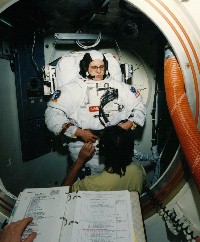 Kathy Sullivan was the first female astronaut to go through the vacuum chamber spacesuit training program required for performing an EVA. I think I was involved in one way or another with all her training runs. When she entered the EVA training program, the prebreathe for men was three hours. However, the conventional wisdom was that women, because of their extra body fat, needed a longer prebreathe and that was set at an additional hour. Kathy gamely accepted the four-hour prebreathe followed by the usual time at vacuum. It made an all day operation with 6 to 7 hours in the suit with nothing to eat or drink but a fruit bar and water from a plastic bag in the suit at body temperature. (A special undergarment had been developed for the women to wear. It was a high-tech version of those now worn to protect from incontinence.) I remember that I was the test director for the first run she made. The photos on the left show Astronaut Kathy Thornton preparing for her first vacuum suit test. It is representative of the first vacuum chamber suit test that Kathy Sullivan participated in. The right photo shows Kathy Sullivan in our Shuttle Airlock test compartment preparing for her training test of suit and airlock operations to get from normal conditions to vacuum operation.
Kathy Sullivan was the first female astronaut to go through the vacuum chamber spacesuit training program required for performing an EVA. I think I was involved in one way or another with all her training runs. When she entered the EVA training program, the prebreathe for men was three hours. However, the conventional wisdom was that women, because of their extra body fat, needed a longer prebreathe and that was set at an additional hour. Kathy gamely accepted the four-hour prebreathe followed by the usual time at vacuum. It made an all day operation with 6 to 7 hours in the suit with nothing to eat or drink but a fruit bar and water from a plastic bag in the suit at body temperature. (A special undergarment had been developed for the women to wear. It was a high-tech version of those now worn to protect from incontinence.) I remember that I was the test director for the first run she made. The photos on the left show Astronaut Kathy Thornton preparing for her first vacuum suit test. It is representative of the first vacuum chamber suit test that Kathy Sullivan participated in. The right photo shows Kathy Sullivan in our Shuttle Airlock test compartment preparing for her training test of suit and airlock operations to get from normal conditions to vacuum operation. 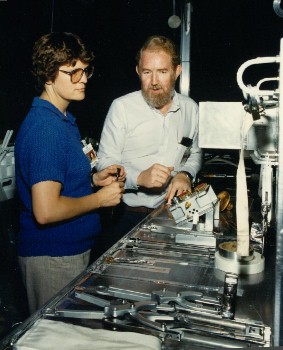
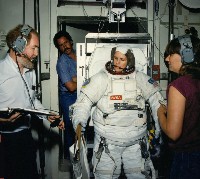 A series of prebreathe studies indicated that 3 hours was not long enough for a thorough prebreathe and so the prebreathe was extended to 3 1/2 hours. Kathy (with lots of support from the rest of the astronauts, I think) said that there was no way to justify a 4 1/2-hour prebreathe for women! Instead everyone agreed on a 4-hour prebreathe for both men and women.
A series of prebreathe studies indicated that 3 hours was not long enough for a thorough prebreathe and so the prebreathe was extended to 3 1/2 hours. Kathy (with lots of support from the rest of the astronauts, I think) said that there was no way to justify a 4 1/2-hour prebreathe for women! Instead everyone agreed on a 4-hour prebreathe for both men and women. | PAGE ONE - Brief summary of the records of the first women in space. Kathy Sullivan just barely misses an opportunity to be the first woman to do an EVA. More photos. |
| PAGE TWO - A time-in-suit record is set. Photos of female test subjects during sequence of suit donning steps. |
| PAGE THREE - More photos of Kathy Sullivan during vacuum chamber dry-run activities for the Hubble Space Telescope Tools Test. |
| OTHER SPACE RELATED PAGES ON MY SITE |
| STS-1 Post-flight EMU Test - The result was not what we had expected. |
| Skylab Medical Experiments Altitude Test (SMEAT)- My photos of the 56-day vacuum test with Bob Crippen, Karol Bobko, and Dr. Bill Thornton. Features Jessica Savitch on the news team that reported the chamber entry and presidential candidate George McGovern who visited during the test. |
| My Own Experience as a Space Suit Test Subject in preparation for Ed White's first U.S. EVA |
| STS-1 Award received for participation in the preparation for the STS-1 Shuttle Mission aboard the orbiter Columbia commanded by astronaut John Young and piloted by astronaut Bob Crippen. The miniature flag was actually flown aboard the orbiter during the mission and was returned to earth to be used for mementos such as this. |
| OTHER RELATED WEB SITES |
| NASA SITE Describing the EMU |
| The First Gals has a good list of all the firsts. |
| Training of a Female Cosmonaut In the history of Soviet/Russian space exploration, there have only been three Russian women-cosmonauts: Valentina Tereshkova, Svetlana Savitskaya, and Elena Kondakova. Nadezhda Kuzhelnaya, 38, is currently training for her first space mission. So far she is the only woman to be seriously considered as a cosmonaut for near-term space missions. Read her story here. |
| The History of Spacesuits This is an About.Com article that begins with the spacesuit for use on Project Mercury. |
| NASA Drops Women's Spacesuit Plans Discovery Channel News article dated March 28, 2003. Note that a special space suit arm was designed and built for Astronaut Kathy Thornton's EVA and the absorbent undergarment designed for women's use in the EVA spacesuit was adopted by most of the men. |
| ENGINEERING AND STEM RELATED WEB SITES |
| types of Engineering Degress - Engineering Degree portal that lists more than 40 unique degree-level engineering programs. Also included are career, licensing, and core competency skills for each degree. |
| Data Science Programs - Data Science Programs is a comprehensive STEM portal dedicated to providing fully accredited programs for current and prospective students. There are more than 800 different STEM programs from over 500 universities across the nation listed. |
| SITE INDEX |
Revised 7/30/03 (after a couple of years on the web)